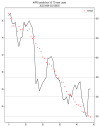Convolutional Neural Network-Based Automatic Analysis of Chest Radiographs for the Detection of COVID-19 Pneumonia: A Prioritizing Tool in the Emergency Department, Phase I Study and Preliminary "Real Life" Results
- PMID: 35328122
- PMCID: PMC8947382
- DOI: 10.3390/diagnostics12030570
Convolutional Neural Network-Based Automatic Analysis of Chest Radiographs for the Detection of COVID-19 Pneumonia: A Prioritizing Tool in the Emergency Department, Phase I Study and Preliminary "Real Life" Results
Abstract
The aim of our study is the development of an automatic tool for the prioritization of COVID-19 diagnostic workflow in the emergency department by analyzing chest X-rays (CXRs). The Convolutional Neural Network (CNN)-based method we propose has been tested retrospectively on a single-center set of 542 CXRs evaluated by experienced radiologists. The SARS-CoV-2 positive dataset (n = 234) consists of CXRs collected between March and April 2020, with the COVID-19 infection being confirmed by an RT-PCR test within 24 h. The SARS-CoV-2 negative dataset (n = 308) includes CXRs from 2019, therefore prior to the pandemic. For each image, the CNN computes COVID-19 risk indicators, identifying COVID-19 cases and prioritizing the urgent ones. After installing the software into the hospital RIS, a preliminary comparison between local daily COVID-19 cases and predicted risk indicators for 2918 CXRs in the same period was performed. Significant improvements were obtained for both prioritization and identification using the proposed method. Mean Average Precision (MAP) increased (p < 1.21 × 10−21 from 43.79% with random sorting to 71.75% with our method. CNN sensitivity was 78.23%, higher than radiologists’ 61.1%; specificity was 64.20%. In the real-life setting, this method had a correlation of 0.873. The proposed CNN-based system effectively prioritizes CXRs according to COVID-19 risk in an experimental setting; preliminary real-life results revealed high concordance with local pandemic incidence.
Keywords: Convolutional Neural Network (CNN); artificial intelligence; chest X-ray; coronavirus disease 2019 (COVID-19); deep learning; prioritization.
Conflict of interest statement
At the time this article is written, Tricarico and Melis are employed at AITEM Solutions, the company which provided the AIppo tool.
Figures










References
-
- WHO Coronavirus Disease 2019 (COVID-19) Situation Report. [(accessed on 4 June 2021)]; Available online: https://covid19.who.int/
-
- Albano D., Bruno A., Bruno F., Calandri M., Caruso D., Clemente A., Coppolino P., Cozzi D., De Robertis R., Gentili F., et al. Impact of coronavirus disease 2019 (COVID-19) emergency on Italian radiologists: A national survey. Eur. Radiol. 2020;30:6635–6644. doi: 10.1007/s00330-020-07046-7. - DOI - PMC - PubMed
-
- ACR Recommendations for the Use of Chest Radiography and Computed Tomography (CT) for Suspected COVID-19 Infection. [(accessed on 4 June 2021)]. Available online: https://www.acr.org/Advocacy-and-Economics/ACR-Position-Statements/Recom...
LinkOut - more resources
Full Text Sources
Miscellaneous

